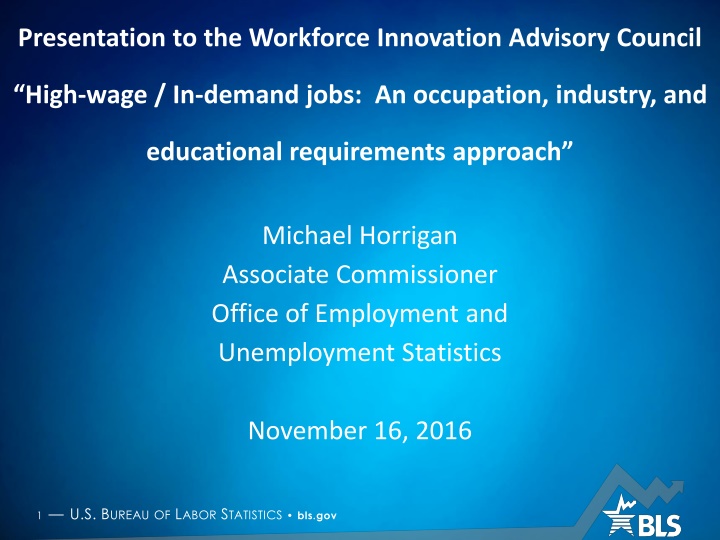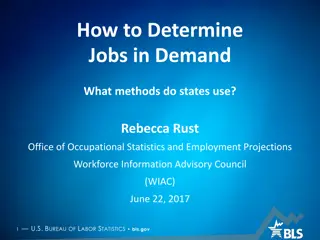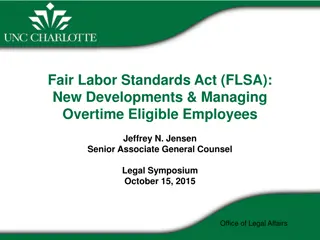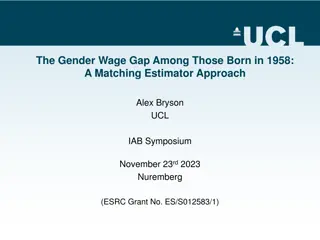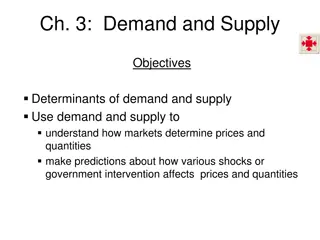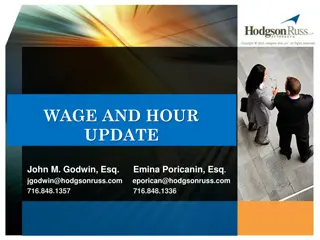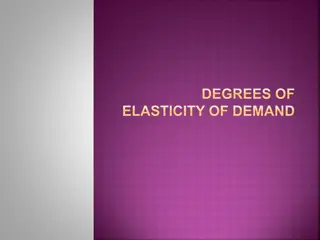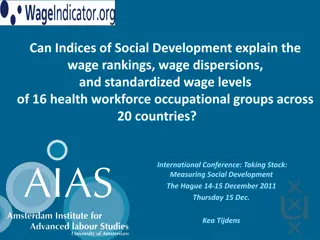High-wage/In-demand Jobs Analysis
This presentation by Michael Horrigan on identifying high-wage/in-demand jobs through an occupation, industry, and educational approach uses data from the Occupational Employment Statistics Survey. The analysis compares OES data from 2012 to 2015, sorting occupations by educational requirements. Various educational attainment categories are considered, such as no formal education, high school, some college, postsecondary awards, associate's, bachelor's, master's, and doctoral degrees.
Download Presentation

Please find below an Image/Link to download the presentation.
The content on the website is provided AS IS for your information and personal use only. It may not be sold, licensed, or shared on other websites without obtaining consent from the author.If you encounter any issues during the download, it is possible that the publisher has removed the file from their server.
You are allowed to download the files provided on this website for personal or commercial use, subject to the condition that they are used lawfully. All files are the property of their respective owners.
The content on the website is provided AS IS for your information and personal use only. It may not be sold, licensed, or shared on other websites without obtaining consent from the author.
E N D
Presentation Transcript
Presentation to the Workforce Innovation Advisory Council High-wage / In-demand jobs: An occupation, industry, and educational requirements approach Michael Horrigan Associate Commissioner Office of Employment and Unemployment Statistics November 16, 2016 1 U.S. BUREAU OF LABOR STATISTICS bls.gov
Goal of the briefing Present an easy to explain approach for identifying high-wage / in-demand jobs by occupation, industry and educational attainment requirement Provide data that can be used by ETA given the WIOA mandate to align ETA training dollars with in-demand occupations 2 U.S. BUREAUOF LABOR STATISTICS bls.gov 2 U.S. BUREAUOF LABOR STATISTICS bls.gov
How does one identify high- wage / in-demand jobs? 3 U.S. BUREAUOF LABOR STATISTICS bls.gov
Pick a data set and time period We used data from the Occupational Employment Statistics* (OES) Survey for this analysis We identify high-wage / in-demand jobs by comparing OES data from 2012 to 2015 Our approach first sorts occupations into groups based on the educational requirements to enter an occupation.** We use data from BLS Employment Projections for this purpose 4 U.S. BUREAUOF LABOR STATISTICS bls.gov 4 U.S. BUREAUOF LABOR STATISTICS bls.gov
*Occupational Employment Statistics Employment and wages for: Over 800 occupations Over 450 industries Average and median wages and by decile Geography nation, states, regions, MSA State partners produce workforce development regions based on county level data 5 U.S. BUREAUOF LABOR STATISTICS bls.gov
**Education typically required to enter an occupation For each of the over 800 occupations in the OES, the BLS projections office assigns an educational attainment category that is typically required for entry: No formal education required High school or equivalent Some college, no degree Postsecondary non-degree award Associates degree Bachelor s degree Master s degree Doctoral and professional Combined in our analysis 6 U.S. BUREAUOF LABOR STATISTICS bls.gov 6 U.S. BUREAUOF LABOR STATISTICS bls.gov
Define what is a high wage for each education group For each formal education group, we defined an occupation as high-wage if their average hourly earnings in 2015 exceeded the national average hourly earnings for their educational attainment group in 2015 For the category, no formal education required, we used $15.00 per hour as the cutoff Obviously these selection choices can be modified 7 U.S. BUREAUOF LABOR STATISTICS bls.gov 7 U.S. BUREAUOF LABOR STATISTICS bls.gov
High wage cutoffs for each education group Education typically required for entry into an occupation No formal education required High school diploma or equivalent Some college, no degree; Postsecondary nondegree award; or Associates degree Bachelor s degree Master s, Doctoral or Professional degree * $15.00 was selected as the cutoff for analysis, the 2015 Average Hourly Wage for occupations that do not require formal education was $12.05 2015 Average Hourly Wage $15.00 * $20.04 $20.20 $39.48 $49.59 8 U.S. BUREAUOF LABOR STATISTICS bls.gov 8 U.S. BUREAUOF LABOR STATISTICS bls.gov
Next, use an equilibrium wage/employment approach For each education category, we focused on strong labor markets in which we observe strong employment growth that is faster than the average growth for that education category*** S Real wages C B A D D Employment 9 9 U.S. BUREAUOF LABOR STATISTICS bls.gov 9 U.S. BUREAUOF LABOR STATISTICS bls.gov
*** Employment grows faster than average, but what about wages? For each education group, we start with high wage occupations that have strong employment growth from 2012- 2015 Since these are high-wage jobs with growing employment opportunities, there can be a natural supply response (to the higher demand by employers) that could result in real wages rising, staying the same or even falling a bit For this exercise, we restricted the analysis to high wage, in- demand occupations in which real wages increased over the 2012-2015 period. 10 U.S. BUREAUOF LABOR STATISTICS bls.gov 10 U.S. BUREAUOF LABOR STATISTICS bls.gov
Caveats, small and large Part of our condition for in-demand is that employment in the occupation grow faster than the average for the relevant education group, but there are two exceptions: Since really small occupations can have large percentage changes with only small level changes, we only looked at occupations in which the 2012 employment level was in the top 90th percentile of occupations ranked by employment size Since some large occupations are growing slower than average but still contributing many new jobs, we include occupations in the top 75th percentile of occupations ranked by change in employment 11 U.S. BUREAUOF LABOR STATISTICS bls.gov 11 U.S. BUREAUOF LABOR STATISTICS bls.gov
Final condition declining industries after 2015Q2 Since the most recent OES data is for 2015, it is possible that some of the 2012 -2015 high-wage, strong employment growth occupations are concentrated in industries that have declined significantly since 2015 As a final condition, we conducted a separate analysis of the impact of industry employment changes from the most recent 12-month period (August 2015 to August 2016) and eliminated occupations that were most likely adversely affected by declining industry employment (aka mining and manufacturing) 12 U.S. BUREAUOF LABOR STATISTICS bls.gov 12 U.S. BUREAUOF LABOR STATISTICS bls.gov
High-wage / in-demand occupations by educational requirement 2012 2015 13 U.S. BUREAUOF LABOR STATISTICS bls.gov
Examples of high-wage / in-demand occupations, 2012-2015 No formal educational credential for entry Occupation 2012 Employment 2015 Employment Employment change 2012-2015 Percent change in Employment 2012-2015 2015 Average Hourly Wage Percent change in Average Hourly Wages 2012-2015 Drywall and ceiling tile installers Tile and marble setters Cement masons and concrete finishers 75,810 88,490 12,680 16.7% $21.88 3.8% 27,050 34,940 7,890 29.1% $21.16 1.7% 135,200 163,360 28,160 20.8% $20.23 2.0% Roofers 97,650 109,720 12,070 12.4% $19.53 1.3% Industrial truck and tractor 496,570 539,810 43,240 8.7% $16.39 2.6% 14 U.S. BUREAUOF LABOR STATISTICS bls.gov operators 14 U.S. BUREAUOF LABOR STATISTICS bls.gov
Examples of high-wage / in-demand occupations, 2012-2015 High school diploma or equivalent typically required for entry Occupation 2012 Employment 2015 Employment Employment change 2012-2015 Percent change in Employment 2012-2015 2015 Average Hourly Wage Percent change in Average Hourly Wages 2012-2015 Sales representatives, services, all other Electricians Bus and truck mechanics and diesel engine specialists Chefs and head cooks Health technologists and technicians, 672,080 886,580 214,500 31.9% $29.98 -0.8% 519,850 592,230 72,380 13.9% $26.72 1.3% 230,030 251,750 21,720 9.4% $22.17 2.1% 97,370 129,370 32,000 32.9% $22.07 -4.7% 84,510 104,020 19,510 23.1% $21.98 -0.5% 15 U.S. BUREAUOF LABOR STATISTICS bls.gov all other 15 U.S. BUREAUOF LABOR STATISTICS bls.gov
Examples of high-wage / in-demand occupations, 2012-2015 Some college (no degree), Postsecondary non-degree award, or Associate s degree typically required for entry Occupation 2012 Employment 2015 Employment Employment change 2012-2015 Percent change in Employment 2012-2015 2015 Average Hourly Wage Percent change in Average Hourly Wages 2012-2015 Dental hygienists Web developers Computer network support specialists Engineering technicians, except drafters, all other Physical 190,290 200,550 10,260 5.4% $34.96 -0.6% 102,940 127,070 24,130 23.4% $33.97 3.3% 167,980 184,570 16,590 9.9% $32.33 3.2% 65,090 70,750 5,660 8.7% $30.20 -0.2% 16 U.S. BUREAUOF LABOR STATISTICS bls.gov therapist assistants 16 U.S. BUREAUOF LABOR STATISTICS bls.gov 69,810 81,230 11,420 16.4% $26.56 2.1%
Examples of high-wage / in-demand occupations, 2012-2015 Bachelor s degree typically required for entry Occupation 2012 Employment 2015 Employment Employment change 2012-2015 Percent change in Employment 2012-2015 2015 Average Hourly Wage Percent change in Average Hourly Wages 2012-2015 Sales managers Human resources managers Software developers, applications 344,730 364,750 20,020 5.8% $62.69 5.0% 98,020 122,780 24,760 25.3% $56.29 3.2% 586,340 747,730 161,390 27.5% $49.12 5.8% Electrical engineers 160,560 178,580 18,020 11.2% $46.80 2.5% Financial analysts 239,810 268,360 28,550 11.9% $45.83 3.0% 17 U.S. BUREAUOF LABOR STATISTICS bls.gov 17 U.S. BUREAUOF LABOR STATISTICS bls.gov
Examples of high-wage / in-demand occupations, 2012.Q2-2015.Q2 Master s, Doctoral, or Professional Degree typically required for entry Occupation 2012 Employment 2015 Employment Employment change 2012-2015 Percent change in Employment 2012-2015 2015 Average Hourly Wage Percent change in Average Hourly Wages 2012-2015 Physicians and surgeons, all other Dentists, general Nurse anesthetists 308,410 322,740 14,330 4.6% $95.05 3.4% 93,580 100,080 6,500 6.9% $82.86 2.0% 34,180 39,410 5,230 15.3% $77.04 0.3% Lawyers 581,920 609,930 28,010 4.8% $65.51 0.6% Pharmacists 281,560 295,620 14,060 5.0% $57.34 0.3% 18 U.S. BUREAUOF LABOR STATISTICS bls.gov 18 U.S. BUREAUOF LABOR STATISTICS bls.gov
Final thoughts 19 U.S. BUREAUOF LABOR STATISTICS bls.gov
Final thoughts We compared 2012 to 2015 because OES is NOT a time series 2012 data are in fact combined reports from November 2010 May 2012 2015 data are combined reports from November 2012 May 2015 OES data are fully representative over a three year basis 20 U.S. BUREAUOF LABOR STATISTICS bls.gov 20 U.S. BUREAUOF LABOR STATISTICS bls.gov
Final thoughts BLS has the goal of converting OES to a time series using both a sample redesign and a modelling approach The ability to identify high-wage / in-demand occupations on a year-to-year basis will be invaluable In particular, our modelling and sampling approach is designed to provide stable and accurate estimates down to the MSA level 21 U.S. BUREAUOF LABOR STATISTICS bls.gov 21 U.S. BUREAUOF LABOR STATISTICS bls.gov
Final thoughts This can provide critical input for ETA in identifying in-demand occupations for local workforce board areas under WIOA These data would provide an important complement to the longer-run perspective that is already provided by state projections offices We intend to convert OES to a time series within current budget constraints, although an increase in sample size would improve the reliability of the estimates 22 U.S. BUREAUOF LABOR STATISTICS bls.gov 22 U.S. BUREAUOF LABOR STATISTICS bls.gov
Contact Information Michael W. Horrigan Associate Commissioner Office of Employment and Unemployment Statistics 202-691-5735 horrigan.michael@bls.gov 23 U.S. BUREAUOF LABOR STATISTICS bls.gov
